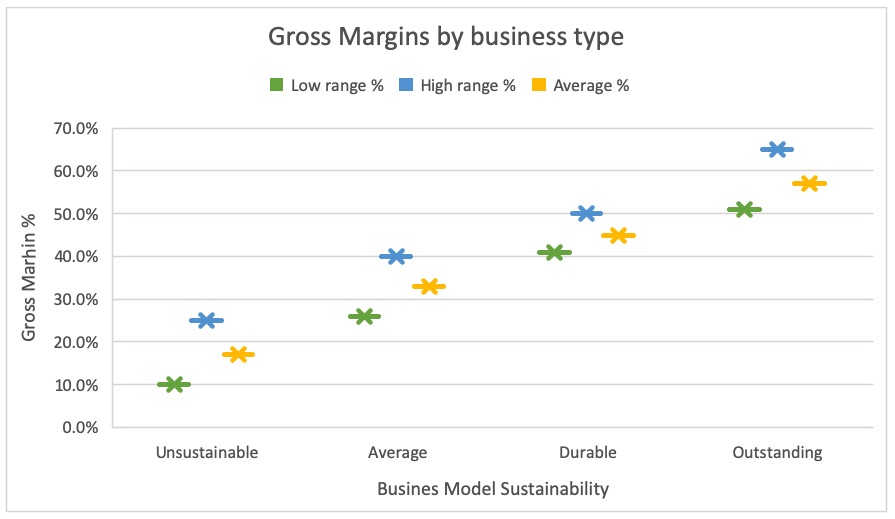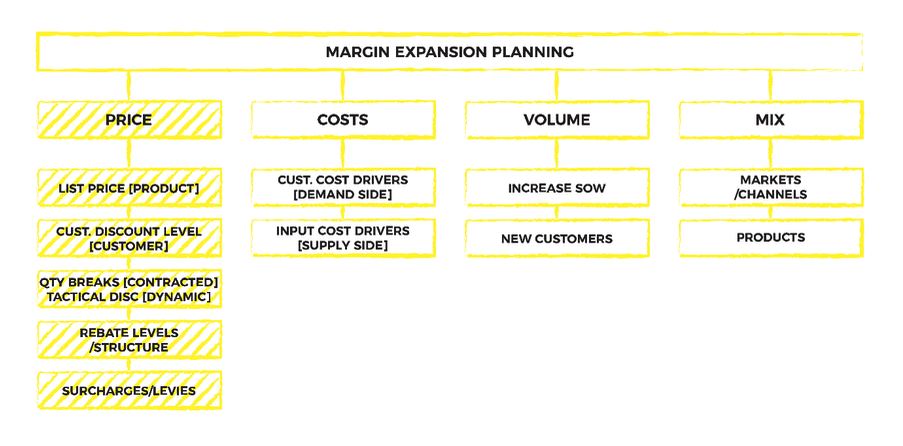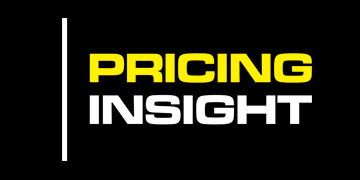There are 11 margin levers to drive more profitable business outcomes. They are each interrelated, and each has a different degree of leverage and sensitivity to profit results.
In this white paper, we present each of these levers and show you how to use them—to drive margin and earnings growth for your business.
Gross Margin management is a critical driver of profitability for any business model. Warren Buffett believes that firms with excellent long-term economics tend to have consistently higher margins.
Durable competitive advantage creates a high Gross Margin percentage because of the freedom to price in excess of cost. Companies can be categorized by their Gross Margin percentage:

Greater than 51% = Outstanding business model
Greater than 40% = Durable competitive advantage.
Less than 40% = Margins eroding due to competition.
Less than 20% = no sustainable competitive advantage
Below is a checklist that can help you identify 11 margin levers to improve profitability.

Price Margin Levers
List price – is your list price structured correctly? Do you have the right price relativities across products?
Customer discount level – Are your customers buying at the right pricing levels? If you have a simple volume vs price discount matrix to set customer pricing, you are probably leaving money on the table.
Quantity price breaks – are your price breaks for various order sizes optimised? In many cases, quantity breaks are straight line linear pricing arrangements. This leaves money on the table.
Tactical discounts – do you have control of the tactical discounting for the business? Many sales reps are given levels or are delegated pricing authority far in excess of what is commercially sustainable. If your EBIT margins are 5% and you allow your sales teams the discretion to offer additional tactical discounts of 5%, you have theoretically put 100% of your EBIT margin at risk. If pricing was a card game, you are holding a losing hand.
Rebate levels & structure – Are your rebates active or passive? If you don’t know what this question means, and you have rebates in your business, then they are most likely passive. In other words, they serve no purpose other than to transfer money from your company bank account to your customers like a dead weight tax.
Rebates are a crucial price and value exchange mechanism–but are poorly understood, managed and optimised, especially in the building materials industry. Take a detailed and informed look at rebates. Don’t listen to anyone who tells you to get rid of rebates entirely; done well, they can be a master stroke–but mostly they are done badly.
Surcharges and levies – Customers often want bespoke products or service—but this means death to profitability when you run a business at scale. Customers are almost always price insensitive to surcharges and levies. Think about the next time you book an airline ticket: Surcharges and levies can make up to 50% of the ticket price.
Most companies don’t utilise their ERP systems effectively to capture substantial revenues and margins with appropriately structured (and rules-bound) surcharges levies. Make a call today to your IT and systems team to find out what surcharges and levies capability your invoicing system can handle. If you transport anything as part of your value proposition, surcharges and should be a mandatory component of your pricing architecture.
Cost Margin Levers – Risk Mitigation
Costs may play no real role in setting prices, but they are crucial to managing margins and earnings. This distinction is subtle–but crucial to understand. There are two main types of costs:
- Costs that are incurred as a result of customer demand – for example, increased frequency of delivery will drive up transport costs; increased demand in general will drive up overtime labour costs. Bespoke or customised orders will drive up a whole range of costs. This is why you need to ensure your price architecture addresses these cost risks that are almost 100% the result of customer demand.
- Input costs – Fuel, energy, raw materials, and other similar items all create margin risk exposures that must be addressed through a pricing mechanism of one type or another. Too many companies have margin exposures though ineffective contract structures that leave them carrying all of the input cost risk with limited upside reward. Dome companies have escalatory rise and fall clauses, but these are often inconsistent, have measurement periods that don’t reflect the real costs, or are simply not managed well resulting in margin leakage.
Volume
Share of wallet strategy
How much share of wallet do you have for the top 20% of your customer base that represents 80% of your revenues? Now, how much potential share of wallet is available from the last 20% of your customers? Share of wallet is possibly the most underutilised revenue opportunity in the playbook. Everyone knows what share of wallet means, but more often than not it is seen as a “nice to have”. Go through the sales key category and work out what share of wallet you have, then identify a matrix of high margin customers with low share of wallet vs. low margin customers with high share of wallet. Create a strategy to drive more sales to higher margin customers.
New Customers
New customers are much harder to sell to than existing customers–this has been documented endlessly. However, what is your new customer acquisition strategy? Customer pipeline strategy requires a much more sophisticated approach than sales trainers would have you believe.
To make a new sale or acquire a new key account you will most likely need to:
- Create awareness of your services and/or products
- Be top of mind when the customer decides to switch suppliers
- Be positioned as a supplier of choice based on your IP and value–not price and product.
- Influence at least 3 – 5 people who play the role of gatekeeper, influencer and economic buyer for your customer.
- Be able to negotiate on value–not traditional positional negotiation techniques as taught by the sales trainers and negotiation schools. These philosophies are neat and usually involve an acronym to remind a student of the process, but they are ineffective.
The Right Mix
Markets and Channels
Where and who you sell are crucial factors in the margin optimisation game. Hilti power tools sell direct to avoid the commoditisation that results from selling through a big box retailer. Other companies like Caterpillar have extremely strong dealer networks that have multiple revenues sources (new units, used units, short term rental units, spare parts and service + finance). This takes pressure off CAT to offer new products at low margins–which can often be the case in capital equipment sales. In fact, it is who you sell to that predict the margin outcome more than any other factor. We live in an age of “market segments of one”. Your pricing opportunity is to identify the value you generate for each individual customer, not each market segment or channel.
Product
It is almost always a self-fulfilling prophecy that what you focus on is what you get. Sales teams often focus on moving high-volume commodity product lines that generate great revenues but little margin. It can be the equivalent of fool’s gold: Whilst the argument that volume contributes to lowering fixed costs is true, there is a corresponding rise in variable costs that often offsets the lowered fixed cost per unit. Driving volume can be a zero-sum game. But there is a far worse penalty for companies with a volume obsession: Because they are focused on looking for big volume opportunities, they miss seeing the three smaller-volume but higher-margin opportunities which, when combined, generate far more free cash flow and margin than the single big opportunity.
The three smaller opportunities require a more sophisticated sales and marketing program. Because this program is not in place, the company defaults to a reality shaped by high volume and low margins.
An analysis of building materials companies shows gross margins to have wide variances over a 10 years period. Some of this can be explained through cyclical margin pressures– however, a significant number of companies have undertaken active margin expansion initiatives to extract 200-300 basis points of margin above what otherwise might have been achieved.
Here are the Gross Margin % ranges over the past 10 years for several key building materials companies that we recently looked at in the Australian market.
Dulux Group Ltd – Top 10% of building materials companies.
Min: 58.64%.
Max: 62.31%.
Current: 59.31%
Boral: Top 40% of building materials companies
Min: 26.93
Max: 33.95
Current: 31.36
Brickworks – Lowest 50% of building materials companies
Min: 22.72
Max: 32.49
Current: 22.72
Fletcher Building: Lowest 20% of building materials companies
Min: 15.64
Max: 25.54
Current: 15.64
It is almost a certainty that when a manufacturer drops below 20% gross margin, EBIT margins will be close to zero. As a rule, manufacturers should target gross margins of at least 30% to maintain a margin of safety and make the economics of volume and price stack up.
What we know from these building manufacturers is that the high margin results from Dulux and Boral are not an accident or lucky circumstance. These two companies have had a relentless focus on pricing and margin for the past 10 years. They have implemented a number of revenue and margin improvement programs, company-wide.
Next Steps
Work through these 11 margin levers with your team and develop a Margin Expansion Action Plan. Identify your high revenue and high margin customer vs your low revenue and low margin customers. Do the same analysis for your products and or services. What key trends or themes emerge? Can these learnings be replicated or applied to new customers or prospects?
Can you review your tactical discounts?
Is your next price increase a flat percentage or is it customised for each product / service and by customer? A customised approach will de-risk customer rejection.
Make margin expansion a daily focus for the next 90 days and then review the results.
What else can you do?
Putting one person in charge of pricing alone doesn’t scale across a business. A centralised pricing hub can make a lot of difference, but you need everyone aligned.
Give everyone in sales, marketing and finance + operations an education on how margins work and what they can do to assist with identifying margin opportunities and implementing margin capture strategies. Margin management is a company-wide responsibility.
Click here to download the whitepaper.






